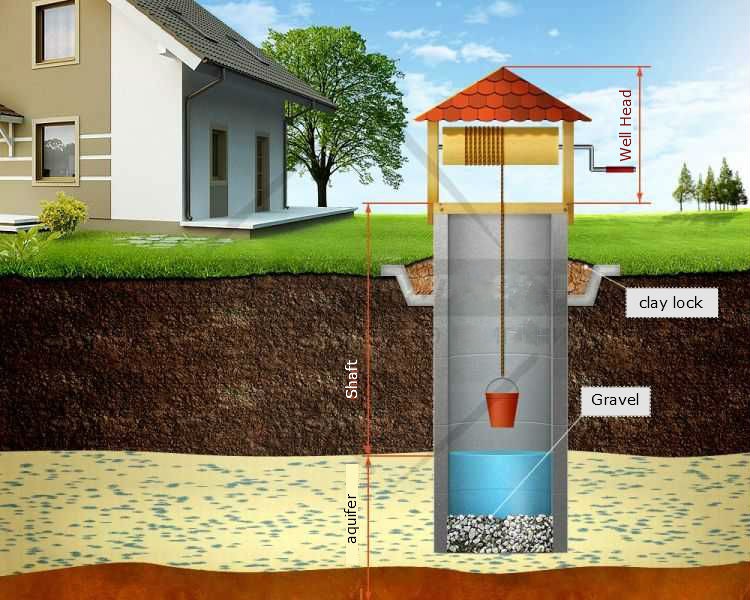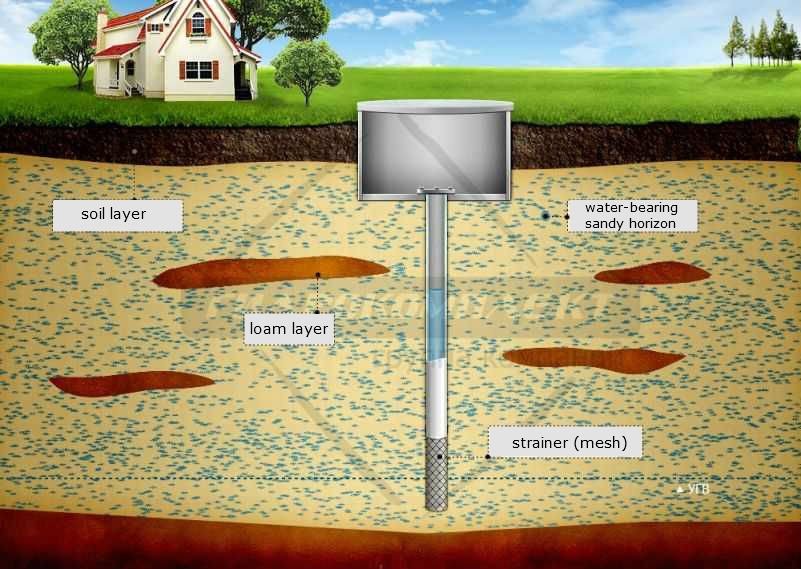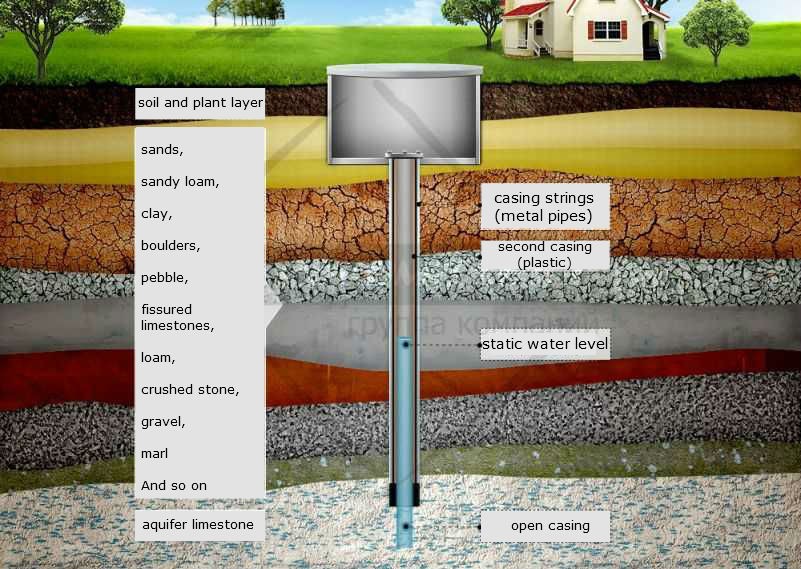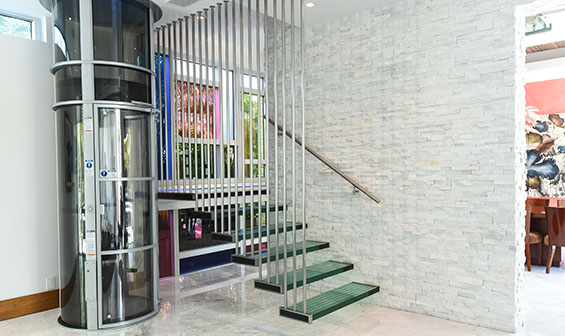Historically, people have always sought to settle near a water source - for centuries, the presence of a nearby stream, spring, or well has been a guarantee of survival. Time has changed the form of autonomous water supply sources, but still, everyone who owns a land lot (even someone who is not going to build there, but, for example, creates a garden) begins with the question: where to get water?
The answer is as famous as there is a settled way of life: underground! The soil beneath our feet resembles a layer cake, in which aquifers and waterproof layers (hydrophores) alternate. Having made a hole in any way to the aquifer, you only need to wait until it is filled with water and scoop it up.
Draw-well
The most simple and obvious solution to the water supply problem is a well. It is the smallest of all possible sources, designed to extract water from the nearest aquifer surface. The problem is that such a source is neither clean nor stable: during a flood or downpour, the level of groundwater rises, soil - a natural filter - do not cope with their treatment, and the water in the well will be turbid or, worse, not suitable for microbiological indicators. In drought, the level of ground waterfalls and the well may dry up.
The obvious solution to get water: the Draw-well

Abyssinian well
An alternative may be an intermediate option between the well and the well - the Abyssinian well. For the first time, such an extraction technique was applied by an English expedition to Africa (hence the name "Abyssinian"). It consists of a narrow pipe with a pointed filter at the end driven into the soil by 3'-4' (10-12 meters). It is clear that it is impossible to place a submersible pump in such a narrow well, and the surface one can "get" water only from a depth of 23'-25' (7-8 meters). All the shortcomings of the open well are inherent in its Abyssinian variety, except, perhaps, the choice of location - the Abyssinian well can be installed even in the house's basement - provided, of course, that the treatment facilities are reliably isolated.
Alternative to well and draw-well

It is not surprising that, as a source of water supply, people have long preferred deeper wells designed to produce water contained between two water-resistant layers. Typically, such an aquifer (horizon) is sand or limestone. The upper water-resistant layer reliably protects against surface pollution. Unlike groundwater, the aquifer supply area can be located tens or hundreds of kilometers from the Well drilling site. All these kilometers of porous rock are natural filters for water purification.
Shallow or unconfined well
As a rule, the nearest aquifer is sandy. And is located relatively close to the surface (on average, 100 feet (30 meters). However, in each case, it depends on the hydrogeology of the site), so "drilling a well on sand" is a quick and economical option, if necessary, for example, to organize water supply of a summer cottage. In this case, the so-called filter column must be used, which will not allow the Well to become clogged with sand quickly. The looser the soil of the aquifer, the more complex the filter must be used for the water intake part of the Well. For example, combine gravel and a fine mesh filter. Actually, the advantages and costs of such a well are exhausted by the cheapness and speed of production. But the list of disadvantages is much more extensive:
Shallow or unconfined well

- the instability of the aquifer - it is impossible to predict how watery the Well will be, how long it will be able to operate: often the "life" of a filter well does not exceed 5-7 years;
- a small amount of water that can be pumped out per unit of time - usually no more than a cubic meter per hour (approximately as much is poured per hour from a standard fully open tap connected to the city water supply system); a well "on sand" is suitable for servicing only one small country house;
- High probability of siltation: in the sand layer, despite filters, tiny particles of soil will inevitably penetrate into the Well, bottom sediment will form. This dense layer of sediment can rise up to the submersible pump and completely shut off the water supply. The less often they use the Well, the more likely this development of events.
Artesian well
The disadvantages of a filter Well are deprived of an artesian Well. Initially, the so-called deep self-flowing Wells (from which water enters the surface under the aquifer pressure) were so-called. However, today any well drilled “on limestone” is considered artesian — in this case, the aquifer is no longer sedimentary but highly cracked rock with a fine-grained structure. The depth of such a well can vary from 30 to 300 meters, which means that the costs (time and resources) for its construction will generally be much higher. However, this is the case when the game is worth the candle:
- the life of such a Well reaches 50 years or more;
- the danger of siltation is minimal - in the rock, there is not so many tiny particles that would clog the mouth of the Well;
- water is distributed throughout the limestone layer and is not located by separate lenses, as in sand; therefore, there is no risk that the aquifer will suddenly dry up;
- Finally, water from such a Well can be extracted an order of magnitude more than from drilled “on the sand”: on average - 1300 gallons (5 cubic meters) per hour for a well in domestic use and 13200 gallons (50 cubic meters) per hour in an industrial well. This means that an artesian Well can serve several homeowners.
- Obviously, the artesian Well will be the most promising option for water supply: it will solve the problem for decades to come, supplying you with excess water.
Artesian well structure diagram

Is there a universal solution?
Today, many companies offer water artesian Well drilling services. Suppose you talk with representatives of several of them. In that case, you may be surprised how different approaches to solving the problem they offer often insist that it is their most effective technology.
The truth is that, as there are no two completely identical lots of land, there is no unique technological solution for drilling a Well for water. Almost any proposal, whether installing a filter, a second plastic technical string in the wellbore, particular pipe diameter, or cementing the annulus, should be accompanied by a clear argument - why this is necessary in this specific case. Therefore, having decided to drill a Well at your site, it is better to contact a large construction and installation organization whose specialists will offer an individual approach. Without overpaying for excesses, get what you need.



